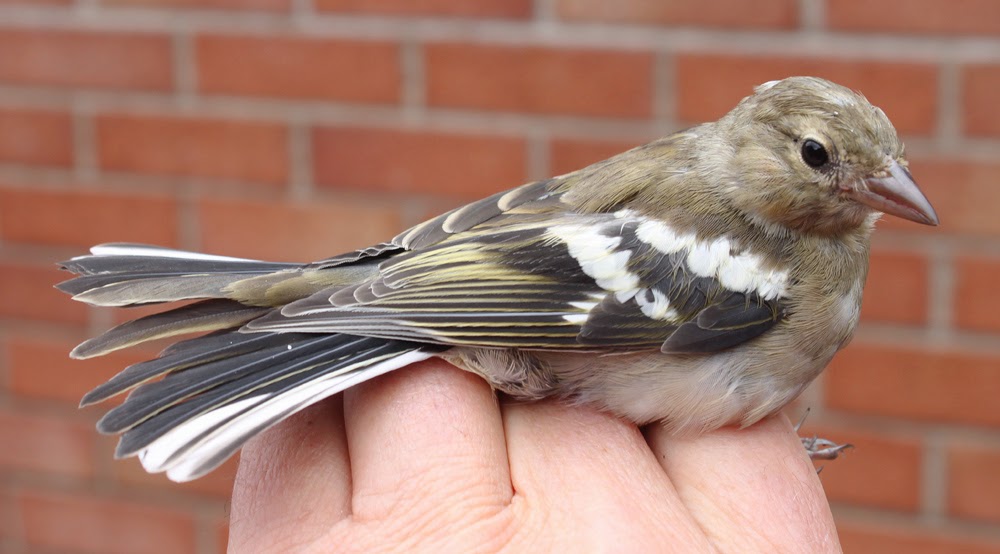School holidays mean babysitting, and then thanks to Bertha no birding when I was marooned indoors for a couple of days. In between I managed to catch a number of still very juvenile Goldfinches, two Chaffinches, a Collared Dove and even a couple of Spadgers, House Sparrows, a species which normally does a rapid disappearing act when a net is in sight.
Collared Dove
Chaffinch - juvenile male
Chaffinch - juvenile female
juvenile Goldfinch
I’ve seen lots of House Sparrows this summer, more than for many years. I’m wondering if anyone else has noticed the same? I’m certain that the many sunny days, lack of rain and generally settled weather of June and July has meant that following a series of disastrous years our old friend the spadger has enjoyed a good breeding season at last.
House Sparrow - juvenile
Spadger is one of many dialect names for our House Sparrow, terms which also include sparr, sparrer, spadger, spadgick, spug and spuggy, mainly in northern England or spur and sprig, mainly in Scotland. I’ll bet there are others I’ve not mentioned, particularly in other parts of the world and if so I’m certain blog readers will let me know.
House Sparrows have lived alongside humans since the Stone Age, and although I’m not quite of that period older readers like me will remember how the House Sparrow was once a hugely successful species. It was a bird so prosperous that its numbers and prevalence often characterised it as a pest, especially to the farming community who’s ripening corn crops became a major object of attention to hordes of House Sparrows.
From Wiki - The House Sparrow has also often been kept as a pet as well as being a food item and a symbol of lust and sexual potency, as well as of commonness and vulgarity. From around 1560 to at least the nineteenth century in northern Europe, earthenware "sparrow pots" were hung from eaves to attract nesting birds so that the young could be readily harvested. Wild birds were trapped in nets in large numbers, and sparrow pie was a traditional dish and because of the association of sparrows with lechery, to have aphrodisiac properties. In the early part of the twentieth century, “sparrow clubs” culled many millions of birds and eggs in an attempt to control numbers of this perceived pest, but with only a localised impact on numbers.
In the 1970s, 1980s and 1990s House Sparrows were rather taken for granted by birdwatchers and other guardians of the countryside - a commonplace bird that could be safely left to its own devices. I remember how in the 1980s the British Trust for Ornithology advised bird ringers that ringing House Sparrows in large numbers was not necessary and probably a waste of resources, so ringers like me simply released House Sparrows as a by-product of a catch without ringing or recording any data on them.
House Sparrow
Then in in the late 1990s there was a sudden realisation that the House Sparrow had lost 70% of its population in just 20 to 30 years. The population fell from about 13 million pairs in the whole of the UK in the 1970s to nearer 5.5 million pairs in 2008.
Even now no one is entirely sure why that happened as it did and why their numbers remain stuck below 6 million pairs, but the culprits named in similar bird declines are mentioned, plus a few new ones linked to the often urbanised existence of the House Sparrow.
It is thought that in contrast to when House Sparrows nested in the thatched roofs of old or the leaky, draughty old buildings of the early twentieth century, our modern buildings have fewer holes and crevices where the birds can nest. The current fashion for the tidy hedges of farm and garden may be a factor too as House Sparrows nest not just in buildings but in dense and unkempt hedgerows.
Domesticated cats take their toll of birds of many species, the House Sparrow on the lawn being a regular target for a well fed moggy. Other research mentions that relatively recent addition to garden birds the Collared Dove as a possible cause of the House Sparrow’s decline because the dove competes for and often wins a bigger share of the same food types on offer; seeing how Collared Doves spend so much time in my own garden I can see why that could be true.
Many House Sparrows live in close proximity to vehicle exhaust emissions of Methyl tertiary butyl ether (MTBE), a chemical in unleaded petrol which is thought to be affecting the abundance of insects that House Sparrows feed to their young. There’s also the now familiar reason implicated in the decline of many bird species, the fact that autumn sown cereal crops leave little stubble for finches, buntings and sparrows to forage in or spilt grain to eat.
I’m rather hoping that our local House Sparrows can repeat this year’s breeding success because the garden wouldn’t be the same without the chirping of a gang of cheeky and characterful House Sparrows.
And when you see them close-up they are actually rather handsome birds aren’t they?
House Sparrow
With a better forecast it's back to birding tomorrow on Another Bird Blog.
Linking today to Anni's blog.
Linking today to Anni's blog.














































































